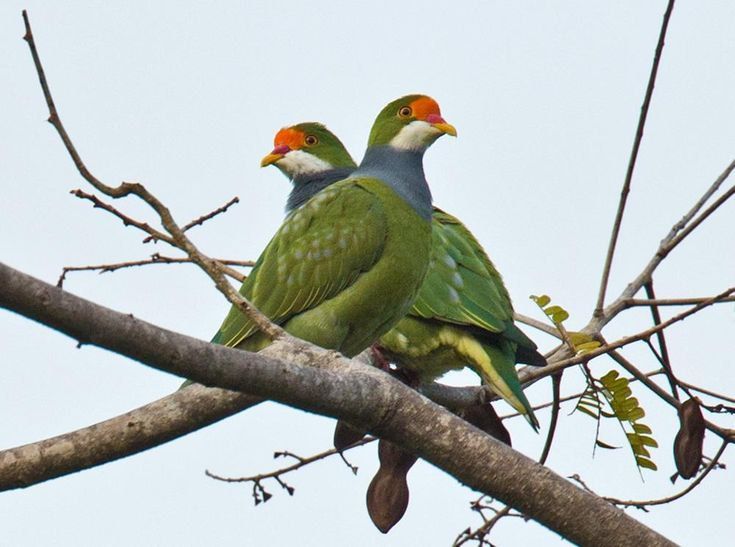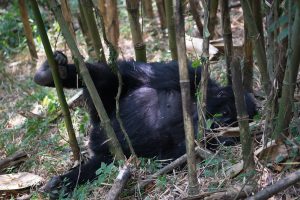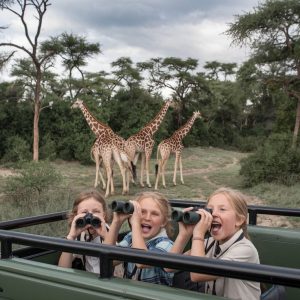Queen Elizabeth National Park is one of the best bird watching destinations in Uganda and Africa as a whole. Located in western Uganda, this park is famous not only for its large mammals and diverse ecosystems but also for its incredible bird diversity. With over 600 bird species recorded, Queen Elizabeth National Park ranks among the most bird-rich protected areas in the world.
What makes Queen Elizabeth National Park important for bird watching?
Queen Elizabeth National Park stands out as a premier birding destination because of its remarkable habitat diversity, which includes savannah grasslands, wetlands, forests, crater lakes, and the Kazinga Channel. These varied ecosystems attract hundreds of bird species, both resident and migratory.
The park’s position along the Albertine Rift Valley further enhances its importance. This region is a biodiversity hotspot where eastern and central African bird ranges overlap, creating exceptional bird-watching opportunities. For this reason, the park draws both professional ornithologists and casual bird enthusiasts from around the world.
How many bird species are found in Queen Elizabeth National Park?
The park hosts over 600 bird species, making it one of the most diverse birding areas globally. This number accounts for nearly 60% of Uganda’s bird species and almost half of Africa’s total bird count.
The species include water birds, forest birds, migratory birds, savannah specialists, and raptors. This diversity ensures that bird watchers can spot an impressive variety of birds within a single safari. The presence of rare species also elevates the park’s birding reputation.
What are the best bird species to see in Queen Elizabeth National Park?
Visitors can spot many iconic species, including:
- Shoebill stork – a highly sought-after species.
- African skimmer – best viewed along the Kazinga Channel.
- Papyrus gonolek – confined to papyrus swamps.
- Great flamingos – commonly seen at Lake Munyanyange.
- African fish eagle – frequently spotted along rivers and lakes.
- Black bee-eater – vibrant and common in forested areas.
- Yellow-billed stork, saddle-billed stork, and marabou stork – seen in wetlands.
The park also provides sightings of raptors such as the martial eagle, African harrier-hawk, and bateleur eagle. The sheer variety appeals to both beginner and expert birders.
Are there migratory birds in Queen Elizabeth National Park?
Yes, Queen Elizabeth National Park hosts a large population of migratory birds, especially during the northern winter months from November to April. Migratory species include lesser kestrels, terns, swallows, steppe eagles, and wagtails.
These migratory birds travel thousands of kilometers from Europe and Asia to winter in the park, making birding during this period particularly rewarding. The combination of resident and migratory birds creates dynamic and ever-changing birding opportunities.
What bird habitats exist in Queen Elizabeth National Park?
The park’s diversity of habitats is one of its biggest strengths for bird watching. They include:
- Savannah grasslands – home to species like crowned plovers, weavers, and hornbills.
- Wetlands and lakes – attract pelicans, herons, and storks.
- Papyrus swamps – critical for papyrus gonolek and shoebill stork.
- Forests – such as Maramagambo Forest, which hosts greenbuls, turacos, and flycatchers.
- Kazinga Channel – a hotspot for water birds including skimmers and cormorants.
Each habitat offers distinct birding experiences, allowing visitors to spot multiple species across different landscapes in a single trip.
Where are the best bird watching spots in Queen Elizabeth National Park?
Some of the top birding spots in the park include:
- Kazinga Channel – famous for large flocks of water birds.
- Maramagambo Forest – excellent for forest species and nightjars.
- Mweya Peninsula – good for open-country and shoreline birds.
- Kyambura Gorge – combines birding with primate tracking.
- Lake Munyanyange – a seasonal spot for flamingos and waders.
- Ishasha sector – home to savannah birds like vultures, storks, and raptors.
These areas are easily accessible and offer high chances of spotting both common and rare species.
Can you see the shoebill stork in Queen Elizabeth National Park?
Yes, the shoebill stork, one of Uganda’s most iconic and rare birds, can be seen in Queen Elizabeth National Park. It prefers swampy areas, particularly along the Ishasha sector and papyrus swamps near Lake George.
Although the shoebill is elusive, guided birding trips significantly increase the chances of spotting it. Its prehistoric appearance makes it a top target for bird watchers worldwide.
What is the best time for bird watching in Queen Elizabeth National Park?
Bird watching is excellent year-round, but the best time is during the dry seasons from December to February and June to August. During these months, trails are easier to access, and birds gather around water sources.
The wet seasons from March to May and September to November are ideal for spotting migratory birds. Although rain may disrupt activities, the abundance of food attracts diverse species, creating rewarding birding conditions.
Are there guided bird watching tours in Queen Elizabeth National Park?
Yes, guided bird watching tours are available and highly recommended. Professional guides and rangers from the Uganda Wildlife Authority and private safari companies lead these tours.
Guides provide expertise in identifying species by sight and sound, ensuring birders make the most of their time in the park. They also take visitors to the best habitats and know where rare birds are most likely to be found.
Can bird watching be combined with game drives in Queen Elizabeth National Park?
Yes, bird watching combines seamlessly with game drives. As visitors explore the park for wildlife such as elephants, lions, and antelopes, they also encounter numerous bird species.
The Ishasha sector, famous for tree-climbing lions, is also excellent for spotting vultures and storks. Similarly, drives along the Kasenyi plains offer chances to see ground-dwelling birds like bustards and lapwings alongside big game.
What equipment should you bring for bird watching in Queen Elizabeth National Park?
Bird watchers should bring essential equipment to maximize their experience, including:
- Binoculars with good magnification.
- A field guidebook to identify bird species.
- A camera with telephoto lenses for bird photography.
- A notebook or birding app for recording sightings.
- Protective clothing such as hats, boots, and neutral-colored outfits.
Carrying the right equipment ensures clear viewing, accurate identification, and memorable birding experiences.
Are boat cruises good for bird watching in Queen Elizabeth National Park?
Yes, boat cruises along the Kazinga Channel are among the best bird watching activities in the park. The channel connects Lake Edward and Lake George and attracts large concentrations of water birds.
Species commonly seen include African skimmers, pelicans, cormorants, herons, and kingfishers. Boat cruises also allow visitors to observe birds up close without disturbing their natural behavior.
What rare or endemic bird species live in Queen Elizabeth National Park?
The park is home to several rare and localized bird species, such as:
- Papyrus gonolek – endemic to papyrus swamps.
- Shoebill stork – rare and highly sought after.
- African skimmer – uncommon elsewhere in Uganda.
- Black bee-eater – colorful and restricted to certain forests.
- White-winged terns – seen seasonally on water bodies.
These species make Queen Elizabeth National Park a valuable birding destination for enthusiasts seeking rarities.
How do seasonal changes affect bird watching in Queen Elizabeth National Park?
Seasonal changes influence bird populations and visibility. During the dry season, birds concentrate around rivers, lakes, and wetlands, making them easier to find. In the wet season, migratory birds arrive, increasing diversity.
Vegetation also changes with the seasons. Lush greenery in the wet months attracts insect-eating species, while open landscapes in the dry season favor raptors and ground-dwelling birds.
Is Queen Elizabeth National Park a good destination for bird photography?
Yes, the park is excellent for bird photography. Open landscapes and waterways provide unobstructed views, while boat cruises allow close approaches to water birds. Photographers can capture both large flocks and rare species in their natural habitats.
Early morning and late afternoon offer the best light conditions for photography. Bringing long lenses, spare batteries, and waterproof covers ensures a successful bird photography experience.
Can beginners enjoy bird watching in Queen Elizabeth National Park?
Yes, beginners can enjoy bird watching in the park. The abundance and visibility of birds make it easy to spot species without advanced skills. Guided tours further help beginners identify species and learn birding techniques.
The combination of birds, mammals, and scenic landscapes ensures beginners enjoy a diverse and rewarding safari experience.
What entry fees apply for bird watching in Queen Elizabeth National Park?
The Uganda Wildlife Authority charges entry fees for the park. As of current guidelines:
- Foreign non-residents: USD 40 per adult per day.
- Foreign residents: USD 30 per adult per day.
- East African citizens: UGX 20,000 per adult per day.
Specialized birding tours may involve additional guiding fees, boat cruise charges, and activity costs.
How does Queen Elizabeth National Park compare to other birding destinations in Uganda?
Queen Elizabeth National Park compares favorably with other Ugandan birding destinations. While Bwindi Impenetrable Forest specializes in Albertine Rift endemics, Queen Elizabeth offers a broader mix of savannah, wetland, and forest birds.
Its accessibility, high species count, and combination with wildlife safaris make it one of the most versatile birding locations in Uganda.
Are there accommodation options for bird watchers near Queen Elizabeth National Park?
Yes, the park offers a wide range of accommodation options to suit different budgets. Options include:
- Luxury lodges such as Mweya Safari Lodge and Kyambura Gorge Lodge.
- Mid-range options including Enganzi Game Lodge and Marafiki Safari Lodge.
- Budget facilities and campsites managed by Uganda Wildlife Authority.
Most lodges are strategically located near key birding spots, ensuring easy access to bird habitats.
Can you combine bird watching in Queen Elizabeth National Park with other Uganda birding tours?
bird watching in Queen Elizabeth can be combined with other birding tours in Uganda. Popular extensions include:
- Kibale National Park for forest species and primates.
- Bwindi Impenetrable Forest for gorillas and Albertine Rift endemics.
- Murchison Falls National Park for riverine birds and raptors.
- Lake Mburo National Park for savannah specialists.
This combination allows birders to maximize species lists and experience Uganda’s diverse ecosystems.
Final Thoughts
Queen Elizabeth National Park is a world-class bird watching destination with over 600 recorded species across diverse habitats. From the elusive shoebill stork to flocks of flamingos and colorful bee-eaters, the park offers unmatched birding opportunities. Its accessibility, combination with wildlife safaris, and expert-guided tours make it suitable for beginners and professionals alike. For anyone interested in birds, Queen Elizabeth National Park remains an essential stop on a Ugandan safari.




